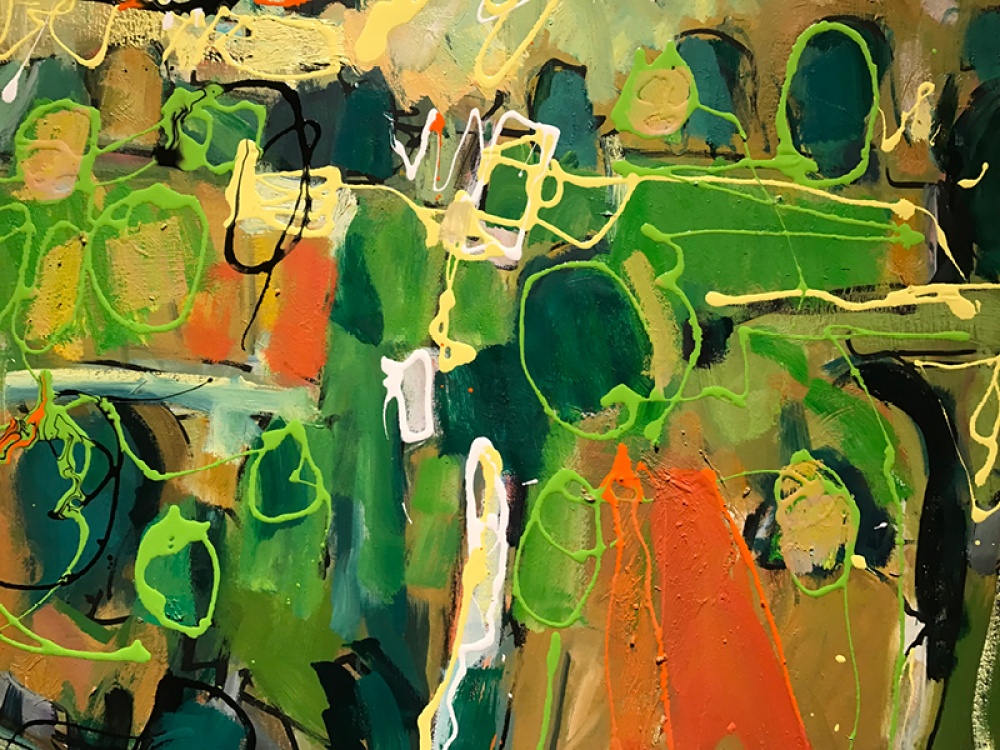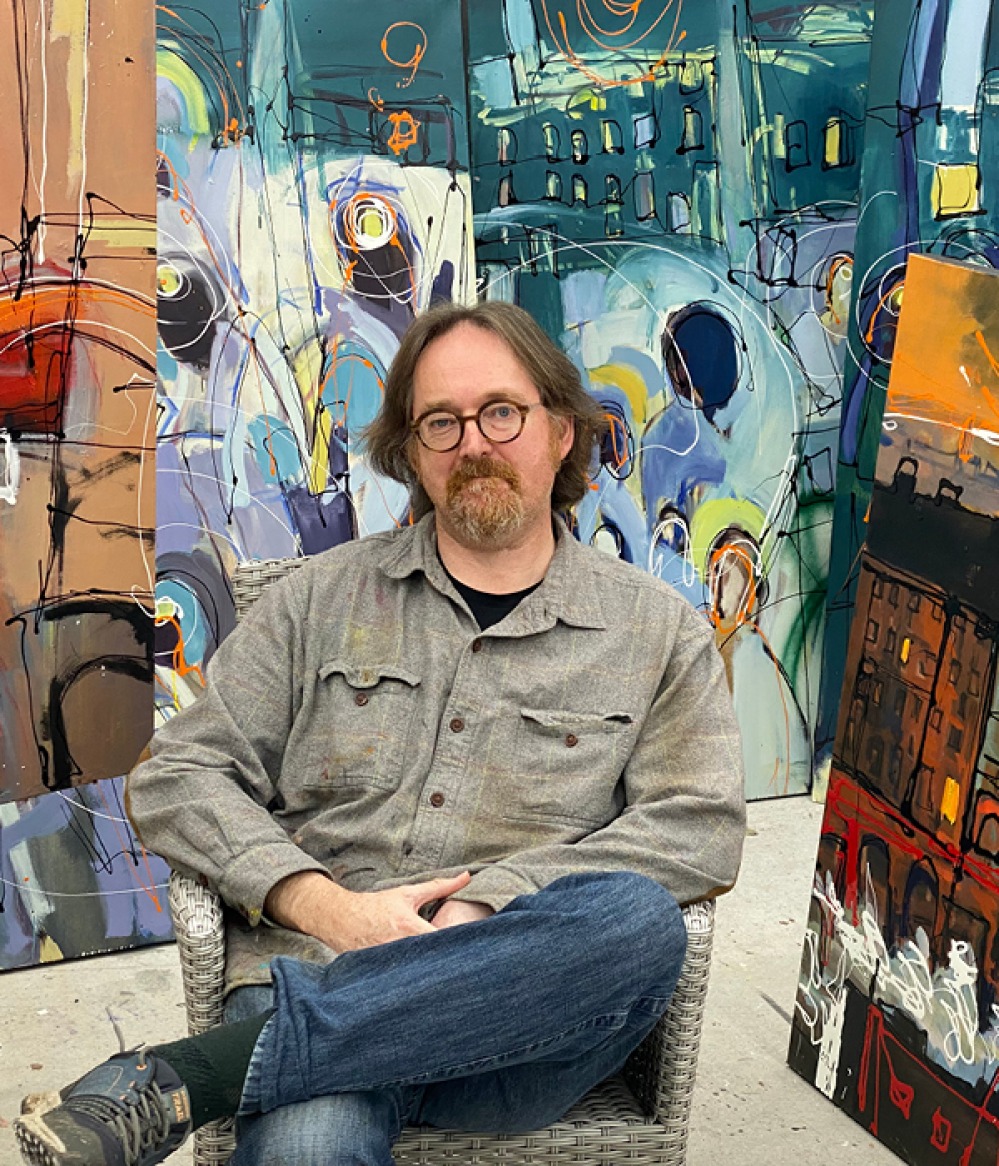How Martin Kinnear’s Paintings Empower People

International award-winning artist, Martin Kinnear, had a vision which led to his powerful series of paintings now on display at The Bowes Museum

Born and raised on a council estate in a deprived post-industrial town in Lancashire, Martin moved south and became a successful advertising copywriter. He remembers being ‘blown away’ by The National Gallery on a visit to London when he was young, and during breaks at work he’d visit the gallery. ‘I remember looking at the pictures and thinking “you’re 30 years old…” (call it a very early mid-life crisis), “if you don’t start to paint now, when?”’
Martin suffered a stroke at the age of 35 which paralysed the left side of his body, and that’s when he says he had an epiphany – a determination to become a professional painter. Entirely self-taught, Martin’s artistic style takes inspiration from a variety of periods, dating back to the Renaissance. He now lives in the Yorkshire Dales and in 2018 was awarded the Medaille d’Argent at the Paris Salon, the salon of Monet and Picasso. ‘[That’s] a really big deal for painters,’ he says. ’It’s like an Olympic medal.’
Martin’s artwork provides a poignant take on industrial Northern England, and it was off the back of the Government’s renewed interest in reinvesting in the region that Boris Johnson acquired one of Martin’s paintings to hang in the Cabinet Room in 10 Downing Street. His painting is now part of the National Archive. ‘I think it’s very important that art does a job,’ Martin says. ‘Art shouldn’t just be shoved in libraries; it should work for its living. Putting a picture in Downing Street, of the North by a Northern artist, sends a very strong message that we are watching him and actually we’d like our levelling up now.’
He has continued to improve and develop his work since then. ’I’ve come to understand that the best paintings don’t tell you what to think, they ask what you think,’ he continues. ‘My work is very lucid. I try to be evocative and I never insist upon a reading. I say “here’s what I think of the North, or what I think of the Dales… what do you think?” I never work from a view. I go somewhere, enjoy the place, get a sense of it, perhaps make a few notes… but I’ll paint from my notes, not from a photograph. I realised the best pictures were in my head rather than the ones I could see. What I really wanted to do was paint these places as I knew them, rather than precisely how they look.’

For this most recent project, Regeneration, Martin dedicated two years to creating large-scale paintings focusing on the theme of change. In his usual style, the paintings are memory composites reflecting Martin’s feelings about the places featured. ‘There’s a saying that says “we all have two lives, and the second begins when we realise we only have one”. For me, that realisation came from having a stroke. I think we all get up, go to work, commute and days roll over days, weeks roll over weeks, but the pandemic just stopped all that. Perhaps for the first time in a lifetime as working adults, we had a chance to be alone with ourselves, and maybe even meet ourselves and ask ourselves, is the person in the mirror somebody I like?’
The paintings are optimistic explosions of colour; they celebrate strong communities and ooze positivity. They include large oil paintings of the North Yorkshire Moors around his home in the village of Wensley, but Martin’s personal favourite is a painting called Council House Days inspired by the estate he grew up on. ‘People come to the Dales not just for the landscape but to find themselves,’ Martin says. ‘This show’s about finding who you really are – and that’s not just a pandemic story, it’s a story about self-awareness. It’s not at all about death, gloom and doom and fear. It’s a show about positivity, self-awareness, optimism and the possibility of positive change.’
‘I realised the best pictures were in my head rather than the ones I could see. What I really wanted to do was paint these places as I knew them, rather than precisely how they look’

The exhibition also features Wordfall – a large animated fall of words inspired by Martin’s visit to High Force waterfall. ‘Just before the show opened, I was invited to The Bowes Museum to be an artist in residence when they were running the Norman Cornish exhibition. They asked me to do some painting in the gallery to get a feel for it and I took the opportunity to visit nearby High Force on the Tees. Because of the noise of the fall, I thought I could be alone with my own thoughts. Waterfalls are like white noise. I wanted to recreate that feeling of being surrounded by verbiage, by chaos, by the pandemic, by the news 24/7 but also be alone and find yourself. That’s what the animation is about. It’s a fall of words and thoughts.’ Less than a week after opening the exhibition, Martin received a note from a man from Sheffield which read: ‘Just stunning. Mind expanding. Loved Wordfall. Made me cry’. ‘That’s why I get out of bed in the morning,’ says Martin. ‘If I can make a show that moves people, it’s well worthwhile.’
After seeing his work on display at The Bowes Museum, Martin feels positive about his project. ‘As artists, we obviously want our work to be seen, but we want it to be meaningful,’ he says. ‘I think we all want to do something meaningful in life, don’t we? What I’m particularly proud of is that I’m one of the first living artists they’ve had exhibit since Jos phine Bowes. To show my deep love and affection for the North to the region is such a huge privilege.’
‘It’s a fantastic area. It’s such a powerhouse of creativity and industry, we should all be proud to live here’
As a part of Regeneration, Martin has collaborated with visual artists and poets across the UK. Part of the project was an open call to all age groups for poetry and art in response to the theme. Jenny Éclair and her fellow podcast presenter Judith Holder, and poet Dr Paul Batchelor from Durham University, judged the hundreds of entries. There was a huge response to this and the winning pieces will be on display as part of the exhibition. ‘I think art should be absolutely democratic,’ says Martin. ‘I think it should be for everybody. Art is what The Bowes Museum is all about – bringing art to the people. I think we should stop seeing problems, and start seeing opportunities. The people of the region are proud, industrious and passionate. They’re loyal, they’re fantastic people and it’s a fantastic area. It’s such a powerhouse of creativity and industry, we should all be proud to live here.’
Martin shares a story about Oscar Wilde when reflecting on his home. ‘He’s invited to go to America on a speaking tour,’ says Martin. ‘He gets to a small town – a mining town with no culture and no great aspirations. A member of the audience says “Mr Wilde, why do you think America is such a violent place?” And Wilde says “it’s because you’ve got such terrible taste in wallpaper”. That sounds like complete Wilde flippancy, but actually he’s making a very serious point. If you live in depressing, depressed places, what sort of person will you become? I think the great strength of the North is the positivity of its people. People make places and we can make this place what we want it to be.’
All images: Martin Kinnear Regeneration Bowes 2022 makinnear.com







